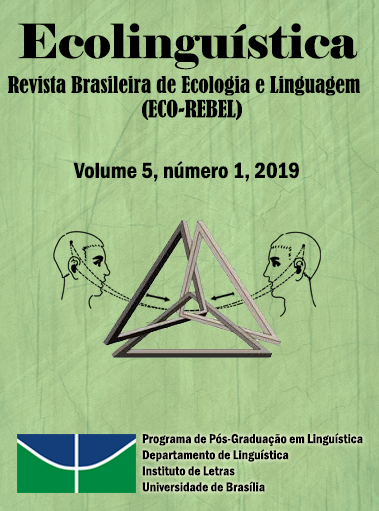Ideas like deer
an ecolinguistic analysis of similes in four nature books
Mots-clés :
Ecolinguistics; simile; EFL; conceptual metaphor theory; new materialismRésumé
Similes animate languages and make communication replete with rich imagery. They are also an indispensable part of any spoken or written text on nature. The present study investigates similes in four nature books by four famous nature authors from different backgrounds through a cognitive lens. Taking into consideration the nature of the source and target domains, each domain was interrogated and, thus, grouped based on fifteen semantically significant categories or variables. Accordingly, the motivation behind their use is unearthed. As conceptual devices for understanding reality, similes are a way of thinking about the living entities. Carefully constructed similes can intensify certain features attributed to a myriad of species over the planet, and thereby enforce sustainable thinking. Finally, the study discusses the importance of nature similes in foreign language learning contexts. It is believed that language learners should be encouraged to write about nature and simultaneously practice the use of creative similes that appropriately fit the ecological context.
Téléchargements
Références
ABRAM, D. Becoming animal: An earthly cosmology.New York: Vintage, 2010.
ACKERMAN, D. A natural history of the senses. New York: Random House, 1990.
ALAIMO, S.Bodily natures: Science, environment, and the material self. Bloomington: Indiana University Press, 2010.
BAKHTIN, M. The dialogic imagination: Four essays. Austin: University of Texas Press, 1981.
COLIN, N. English and Swedish animal idioms: A study of correspondence and variation in content and expression. University Essay from Karlstads Universitet/Institutionen för Kultur och Kommunikation, 2006.
COOLE, D. & FROST, S. Introducing the new materialisms. In:COOLE,D.;FROST,S.(eds.).New materialisms: Ontology, agency, and politics.London: Duke University Press, 2010, p. 1-43.
CRYSTAL, D. English as a global language. Cambridge, UK: Cambridge University Press, 2003.
FELDMAN, J. From molecule to metaphor: A neural theory of language.Cambridge, Mass: MIT Press, 2006.
GOATLY, A. The language of metaphors. London: Routledge, 1997.
GRIFFITHS, J. Pip pip: A sideways look at time. London: Flamingo, 1999.
IOVINO, S. Material ecocriticism: Matter, text, and posthuman ethics. In:MÅ°LLER,T.;SAUTER,M. (eds.), Literature,ecology, ethics: Recent trends in ecocriticism(pp. 51”“68).Heidelberg: Universitätsverlag Winter, 2012.
JAMIE,K.Sightlines. London: Sort of Books, 2012.
KÓˆVECSES, Z. Metaphor: A practical introduction. Oxford: Oxford University Press, 2010.
LAKOFF, G.;JOHNSON, M. Metaphors we live by. Chicago: University of Chicago Press, 1980.
LAKOFF, G.;TURNER, M. More than cool reason. Chicago: University of Chicago Press, 1989.
LAKOFF, G. The contemporary theory of metaphor. In Ortony,A.(ed.), Metaphor and thought. Cambridge, England: Cambridge University Press, 1992, p. 202-251.
LAKOFF, G. The Neural Theory of Metaphor. In:R. GIBBS, R.(ed.), Cambridge handbook of metaphor and thought. New York: Cambridge University Press, 2008, p.17”“38.
LAZAR, G. Meanings and metaphors: Activities to practice figurative language. Cambridge: Cambridge University Press, 2003.
Leopold, A. A sand county almanac: And sketches here and there. New York: Oxford University Press, 1987.
MARLAND, P. The gannet skull versus the plastic doll's head: Material 'value' in Kathleen Jamie’s 'Findings'. Green Letters: Studies in Ecocriticismv. 19, n. 2, 2015, p. 121-131.
NAESS, A. The shallow and the deep, long-rangeecology movement: A summary. Inquiry: AnInterdisciplinary Journal of Philosophy and the Social Sciencesn. 16, 1973, p. 95”“100.
NETTLE, D.; ROMAINE, S. (2000). Vanishing voices: The extinction of theworld’s languages. Oxford: Oxford University Press.
PETERS, P. Similes and other evaluative idioms in Australian English. In:SKANDERA, P.(ed.),Phraseology and culture in English. Berlin:Mouton de Gruyter, 2007, p. 235-256.
PIERINI, P. Simile in English: From description to translation. Círculo de linguisticaaplicada a la comunicaciónn. 29, 2007, p. 21”“43.
RAKUSAN, J. Cultural diversity in crossing the boundaries between human and animal in language ”“Germanic and Slavic similes and metaphors. Collegium antropologicumv.28, n. 1, 2004, p.171”“181.
SEMINO, E. (2005). Mind style.In BROWN,E. K.;ASHER,R. E.;SIMPSON, J. M. Y.(eds.), Elsevier Encyclopedia of language and linguistics. Amsterdam: Elsevier, 2005, p.142-48).
SHEPHERD,N.The living mountain. Aberdeen University Press, 1997.
STAMENKOVIĆ, D. (2011). Cognitive Semantic Aspects of Animal Similes in English. In:KOVAÄŒEVIĆ, M. et al. (4ds.), SavremenaprouÄavanja jezika i književnosti ”“Godina II/Knjiga I ”“Zbornik radova sa II nauÄnog skupa mladih filologa Srbije. Kragujevac: Filološko-UmetniÄki Fakultet, 2011, p. 187-197.
Téléchargements
Publié-e
Comment citer
Numéro
Rubrique
Licence
Autores que publicam nesta revista concordam com os seguintes termos:
Autores mantêm os direitos autorais e concedem à revista o direito de primeira publicação, sendo o trabalho simultaneamente licenciado sob a Creative Commons Attribution License o que permite o compartilhamento do trabalho com reconhecimento da autoria do trabalho e publicação inicial nesta revista.
Autores têm autorização para assumir contratos adicionais separadamente, para distribuição não exclusiva da versão do trabalho publicada nesta revista (ex.: publicar em repositório institucional ou como capítulo de livro), com reconhecimento de autoria e publicação inicial nesta revista.
Autores têm permissão e são estimulados a publicar e distribuir seu trabalho online (ex.: em repositórios institucionais ou na sua página pessoal) a qualquer ponto antes ou durante o processo editorial, já que isso pode gerar alterações produtivas, bem como aumentar o impacto e a citação do trabalho publicado (Veja O Efeito do Acesso Livre).



3.png)



